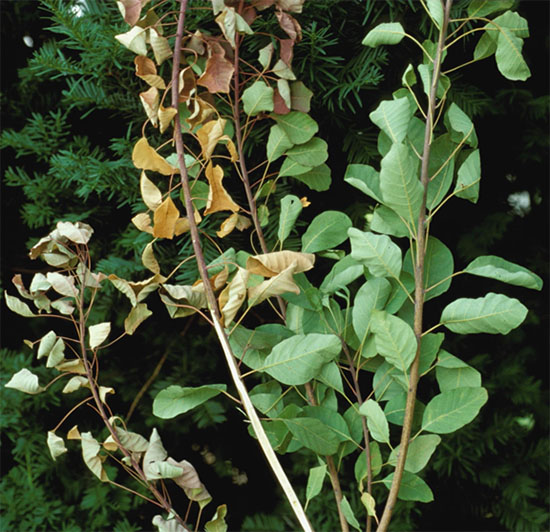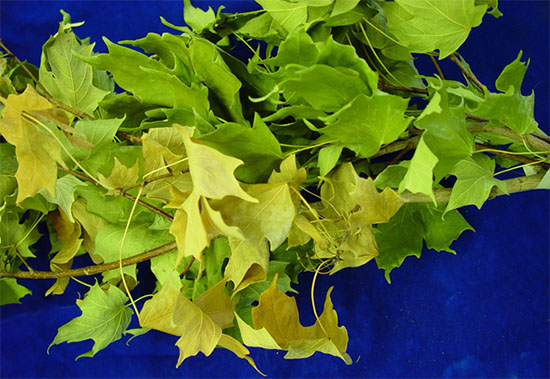Issue 11, July 7, 2015
Verticillium Wilt of Woody Ornamentals
So far this year we've had 5 confirmed cases of Verticillium wilt in woody ornamentals at the University of Illinois Plant Clinic. Four were Japanese maple trees, and the fifth was a redbud. Verticillium wilt is fairly common in Illinois. This fungal disease is usually lethal to the host, and it unfortunately boasts a huge host range. The fungus can survive in the soil for several years, making control difficult.
There are over 300 hosts for Verticillium wilt, though that includes both woody and herbaceous plants. Common woody hosts in Illinois include maple, ash, elm, redbud, smoke tree, tulip tree, and oaks in the red oak group. There are a number of species of Verticillium which cause the wilt disease, with different species or strains of the pathogen exhibiting distinct host plant preferences. This is important to know; if a redbud in your landscape succumbs to Verticillium wilt, that doesn't spell immediate doom for your maple (though it is something to be aware of).
The fungus invades the plant tissue, usually through the roots. Once inside, the fungus colonizes the vascular system, restricting water movement within the host plant. This leads to wilting, decline, and eventually death. The disease is most severe in Illinois during cool to warm weather, and less prevalent in hot weather. A common symptom in woody hosts is flagging, where the foliage on an individual branch suddenly wilts and dies. Also common is the wilting of foliage on only one side of the tree or shrub. Wilting symptoms are usually seen in Illinois starting in early July, though they may begin as early as March and continue through November when the leaves drop from the trees. An overall yellowing of the leaves may precede the wilting, while some hosts (such as ash) may defoliate while still green without any yellowing or wilting.

Smoke tree displaying symptoms of Verticillium wilt. Note the flagging branches, and that approximately half of the tree is affected while the other half appears healthy. Photo credit: University of Illinois Plant Clinic.
Environmental factors influence severity of the symptoms. Plants under stress due to drought, flooding, nutrient deficiencies, or salt toxicities are often more susceptible to the pathogen, and decline more rapidly. With the several years of environmental stress we've experienced (drought followed by difficult winters followed by flooding), it's been no surprise when a sample tests positive for this pathogen.

Yellowing of maple leaves in a sample that tested positive for Verticillium wilt. These leaves would have become brown and wilted as the symptoms progressed on the tree. Photo credit: University of Illinois Plant Clinic
Management for Verticillium wilt includes improving host vigor by mulching the base of the plant lightly, watering during periods of dryness lasting more than a few weeks, pruning out dead wood, fertilizing when appropriate, and scouting for and responding to other pest problems. These steps can all be taken as preventative measures. If a tree or shrub begins to display symptoms of Verticillium wilt, a sample can be sent to the Plant Clinic for testing. Because the disease is often lethal, some people question the necessity for testing. We recommend testing because if the plant is indeed infected with Verticillium, that will restrict your options for replanting. Once a plant has succumbed to Verticillium wilt, we recommend replanting that area with non-susceptible species. Apple, pear, crabapple, gingko, sycamore, walnut, willow, rhododendron and azalea, and oaks in the white oak group are some woody plants that are considered non-susceptible to Verticillium wilt. In addition, all conifers are considered resistant to Verticillium wilt.
To test for the presence of Verticillium wilt, collect a sample of a symptomatic branch (one with yellowing or wilting leaves that are not completely dead). The branch should ideally be 8-10 inches long and approximately 1 inch in diameter. Once the sample arrives at the Plant Clinic, we culture the inner branch tissue to check for the presence of the fungus. For a more complete list of non-susceptible plants, please contact the Plant Clinic at plantclinic@illinois.edu and request a copy of our new Verticillium Wilt fact sheet. (Diane Plewa)
Author:
Diane Plewa